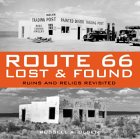Route 66 Lost & Found: Ruins and Relics Revisited, by Russell A. Olsen
The author makes a good case for the assertion that "Route 66 was born in Oklahoma, and its father was Cyrus Avery." Even today, there are still more drivable miles of the original highway in OK than any other state. He traces the development of the highway as the route for Dust Bowlers, escaping the ravages of the depression and drought, headed for a better life in California, the effect of the transport of materials to support WWII, and the rapid growth of roadtripping after the end of the war. In many ways, Route 66 businesses were victims of their own success. The need for improved highways caused more and more bypasses to be constructed around previously thriving cities and towns to serve the needs of highway travelers eager for speed. Peach Springs, Arizona, has the dubious distinction of being the town bypassed by the greatest distance—36 miles.
The best part of this book is the detail Olsen shares with his readers. For example, he explains that Miami, Oklahoma, is pronounced Mi-am-UH, not My-am-EE, and reveals that the old Bent Door Café in Adrian, Texas, was actually constructed from a former air force control tower. He includes evocative descriptions like the piece about the Longhorn Ranch, a classic tourist trap in Moriarty, New Mexico. Olsen also made an impressive effort to photograph locations from the same vantage point used by the original photographers. He hiked out into the desert to reproduce a vintage photograph of Cool Springs Camp, Arizona, and he captured a fabulous shot of an eminently photogenic abandoned gas station in Gascozark, Missouri.
The photographs will serve to enrich any roadtripper's drive on the old highway once known as "America's Main Street." At the beginning of the book project, the author had about 400 vintage photographs that he winnowed down to seventy-five. We can only hope that there will, one day, be a volume two of this excellent work.
Mark
7/04/04

